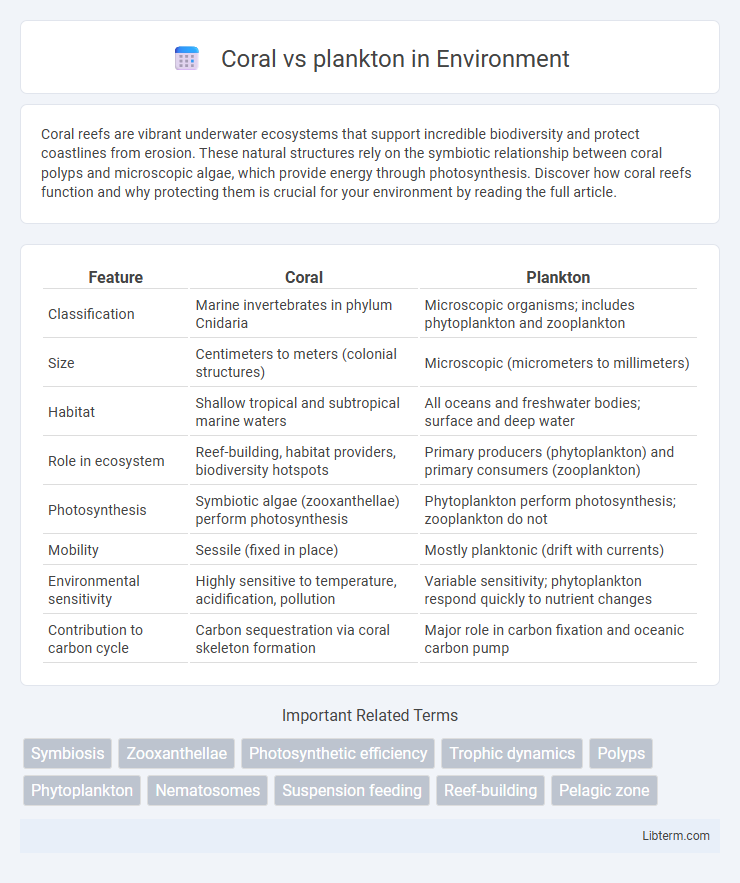Coral reefs are vibrant underwater ecosystems that support incredible biodiversity and protect coastlines from erosion. These natural structures rely on the symbiotic relationship between coral polyps and microscopic algae, which provide energy through photosynthesis. Discover how coral reefs function and why protecting them is crucial for your environment by reading the full article.
Table of Comparison
| Feature | Coral | Plankton |
|---|---|---|
| Classification | Marine invertebrates in phylum Cnidaria | Microscopic organisms; includes phytoplankton and zooplankton |
| Size | Centimeters to meters (colonial structures) | Microscopic (micrometers to millimeters) |
| Habitat | Shallow tropical and subtropical marine waters | All oceans and freshwater bodies; surface and deep water |
| Role in ecosystem | Reef-building, habitat providers, biodiversity hotspots | Primary producers (phytoplankton) and primary consumers (zooplankton) |
| Photosynthesis | Symbiotic algae (zooxanthellae) perform photosynthesis | Phytoplankton perform photosynthesis; zooplankton do not |
| Mobility | Sessile (fixed in place) | Mostly planktonic (drift with currents) |
| Environmental sensitivity | Highly sensitive to temperature, acidification, pollution | Variable sensitivity; phytoplankton respond quickly to nutrient changes |
| Contribution to carbon cycle | Carbon sequestration via coral skeleton formation | Major role in carbon fixation and oceanic carbon pump |
Introduction to Coral and Plankton
Coral consists of marine invertebrates within the class Anthozoa, forming complex colonies of genetically identical polyps that build calcium carbonate skeletons vital for reef ecosystems. Plankton encompasses diverse microscopic organisms drifting in water columns, primarily divided into phytoplankton (photosynthetic) and zooplankton (animal-like). Both corals and plankton play essential roles in oceanic food webs and carbon cycling, with corals providing habitat structure and plankton serving as foundational primary producers and prey.
Fundamental Differences Between Coral and Plankton
Coral, marine invertebrates of the class Anthozoa, form rigid calcium carbonate skeletons and establish symbiotic relationships with photosynthetic zooxanthellae, supporting reef ecosystems. Plankton, consisting of diverse microscopic organisms including phytoplankton and zooplankton, drift in water columns and serve as foundational components of aquatic food webs. The fundamental differences lie in corals' sessile, colonial structure and symbiosis versus plankton's free-floating, often unicellular form and primary role in nutrient cycling.
Biological Classification and Structure
Corals belong to the phylum Cnidaria, class Anthozoa, characterized by a hard calcium carbonate exoskeleton and polyps with tentacles containing stinging cells called nematocysts. Plankton, a diverse group including phytoplankton (photosynthetic algae) and zooplankton (tiny animals), are classified across multiple phyla such as Protista and Arthropoda, typically lacking rigid structures and possessing microscopic or near-microscopic sizes. The coral's rigid skeletal structure supports reef building, whereas plankton's varied biological forms serve as foundational components of aquatic food webs.
Habitat and Distribution
Coral thrives in warm, shallow waters of tropical and subtropical oceans, primarily forming extensive reef systems in areas like the Great Barrier Reef and the Caribbean Sea. Plankton, consisting of diverse microscopic organisms, inhabit virtually all aquatic environments worldwide, from surface waters to deep ocean layers, drifting with currents. While corals are sessile and fixed to solid substrates, plankton are free-floating, enabling a broad distribution across marine and freshwater habitats.
Reproduction and Life Cycle
Coral reproduction occurs through both sexual spawning, where eggs and sperm are released simultaneously into the water, and asexual budding, allowing colonies to expand. In contrast, plankton predominantly reproduce sexually with rapid life cycles, often completing development within days to weeks, supporting their role as primary producers and food sources in marine ecosystems. Coral life cycles involve sessile polyp stages forming reefs over decades, while plankton exhibit diverse, short-lived life stages adapted to fluctuating ocean conditions.
Ecological Roles in Marine Ecosystems
Corals provide essential habitat structures supporting high biodiversity and facilitating nutrient cycling in marine ecosystems, serving as critical breeding and feeding grounds for numerous species. Plankton, including phytoplankton and zooplankton, form the base of the marine food web, driving primary production and carbon fixation essential for energy transfer across trophic levels. Together, corals and plankton maintain ecosystem stability, influence biogeochemical cycles, and support fisheries and global ocean health.
Interactions and Relationships
Corals and plankton maintain a symbiotic and ecological relationship crucial for marine ecosystems. Corals benefit from zooplankton as a vital food source, capturing these microscopic organisms with their tentacles to obtain essential nutrients. Meanwhile, phytoplankton contributes to coral health indirectly by producing oxygen and forming the base of the marine food web that supports diverse coral reef inhabitants.
Adaptations to Environmental Changes
Coral exhibits symbiotic relationships with zooxanthellae algae, enabling efficient energy production through photosynthesis and enhancing resilience to temperature fluctuations. Plankton demonstrate rapid reproductive cycles and genetic variability, allowing swift adaptation to shifting ocean conditions such as nutrient availability and pH changes. Both organisms employ unique physiological and behavioral adaptations crucial for survival amid increasing environmental stressors like ocean warming and acidification.
Importance to Ocean Health
Coral reefs provide critical habitats that support over 25% of marine species, enhancing biodiversity and coastal protection. Plankton, as primary producers, form the base of the marine food web and drive global carbon cycling by sequestering vast amounts of CO2. Both coral ecosystems and plankton populations are essential for maintaining ocean health, regulating climate, and sustaining fisheries worldwide.
Conservation Challenges and Future Outlook
Coral reefs face severe conservation challenges due to climate change-induced ocean warming and acidification, leading to mass bleaching and habitat loss, while plankton populations are impacted by changing ocean chemistry and nutrient cycles that disrupt marine food webs. Efforts to restore coral ecosystems involve advanced techniques such as coral gardening and assisted evolution, whereas plankton conservation requires global monitoring of ocean conditions and mitigating pollutants that affect microbial balance. The future outlook depends on integrated marine management strategies that address both coral resilience and plankton ecosystem health to sustain biodiversity and fisheries productivity.
Coral Infographic

 libterm.com
libterm.com